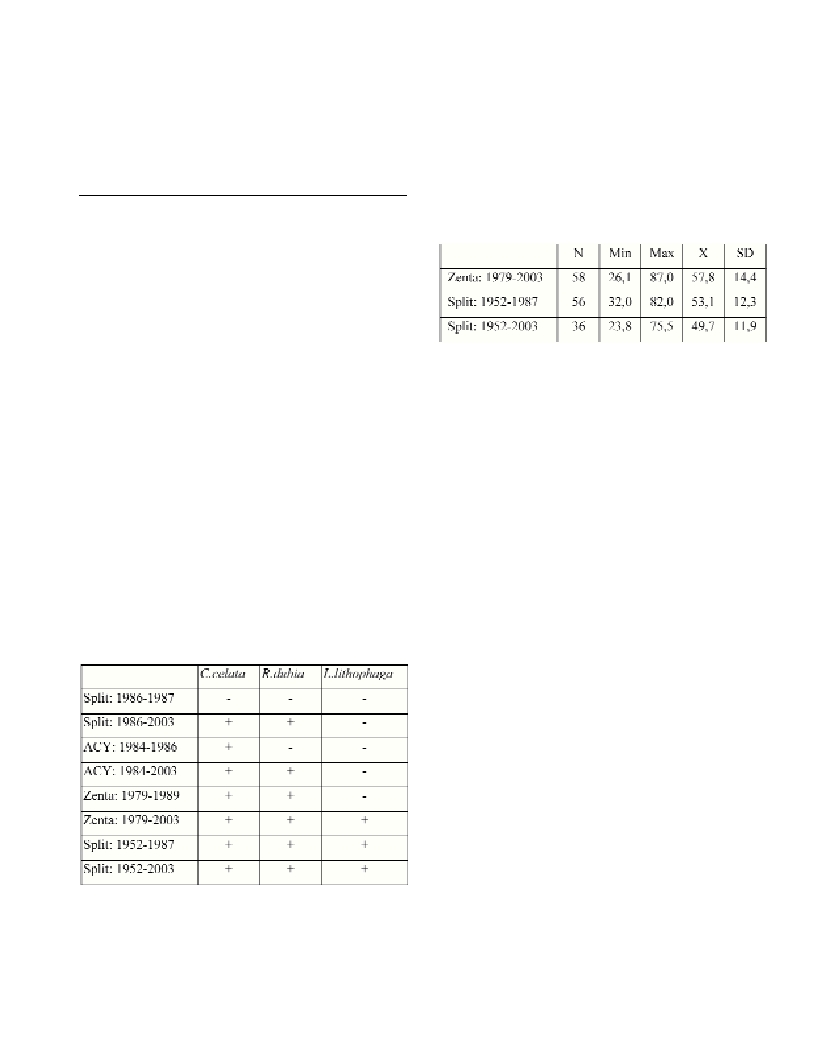THE DATE-SHELL LITHOPHAGA LITHOPHAGA L. COLONIZATION OF IMMERSED ROCKS
AT THE EASTERN PART OF THE ADRIATIC SEA
Ivana Grubelic
*
, Ante Simunovic, Marija Despalatovic
Institute of Oceanography and Fisheries, Split, Croatia - * grubelic@izor.hr
Abstract
The aim of this paper is to show the mode and the time during which the date-shell penetrates an intact rock immersed into the sea, as well
as its development and the structure of its population in various periods.
Key words: Lithophaga lithophaga, colonization, immersed rocks
Rapp. Comm. int. Mer Médit., 37,2004
520
Introduction
There are bibliographic data about the distribution of the date-
shell(1), its reproductive cycle (2, 3), biology and ecology in the
eastern part of the Adriatic (4), the method of burrowing the
rock(5,6). Because of its specific life in the rock and its
inaccessibility, the date-shell is still partly unknown. Our results
contribute to the new knowledge about the date-shell and help decide
on the profitability of its farming in immersed rocks.
Materials and Methods
In order to identify the time and method of date-shell penetration
into the rock habitat, and to monitor the development of its population
in various periods, the rocky breakwaters of the marinas around Split
were chosen, since the exact time of their immersion into the sea has
been known. The research was conducted in ACY marina in 1986
(built in 1984), in marina Split (built in 1952 and 1986) in 1987, and
in marina Zenta (built in 1979) in 1989. The research was repeated in
the same sites in 2003. Sample collecting was done by scuba divers,
using the method of direct collecting from the area of
1/4
m
2
.
Results and Discussion
The results of the research show (Tab. 1) that after two years a
sponge Cliona sp. was in the rock (ACY), and after ten years shellfish
Rocellaria dubiawas present (Zenta). Besides Cliona sp.and
R.dubia, the population of Lithophaga lithophaga(Tab. 2)was well
developed in the rock that has been in the sea for 35 years (Split). The
biometric characteristic of the date-shell population is shown in
Table2. Dominate specimens were of 40-49 mm (28,6%), 60-69 mm
(25,0%) and 50-59 mm (23,2%). The largest date-shell was 82,0 mm
long, 23,0 mm wide and 25,31 g of weight. According to old data, it
grew in the rock for about 25 years.
The research was repeated in September 2003, and the obtained
results (Tab 1) are: Cliona sp. and R. dubiahave developed in the rock
that has been in the sea for 19 years (ACY). Both species completely
penetrated the rock up to about 4 cm. However, the date-shell has not
yet developed. Besides Cliona sp. and R. dubia, the population of
date-shell was found in the rocks that has been in the sea for 24 years
(Zenta) and for 51 years (Split). The biometric characteristics of the
date-shell populations are shown in Table 2. Dominate specimens in
Zenta (1979-2003) were of 60-69 mm (31,0%) and 50-59 mm
(22,4%). The largest date-shell was 87,0 mm long, 23,9 mm wide and
21,1 g of weight. According to old data, it grew in the rock for about
14 years. Dominate specimens in Split (1952-2003) were of 40-49
mm (30,6%), 50-59 mm (27,8%) and 30-39 mm (22,2%). In this
population were 6 empty shells (16,7%). The largest date-shell was
75,5 mm long, 19,7 mm wide and 17,5 g of weight. According to old
data, it grew in the rock for about 41 years.
It can be concluded that the populations of the date-shell, that lived
in the rocks immersed into the sea 24 and 35 years ago, have the
characteristics of a healthy population, while the population of the
date-shell in the rock immersed 51 years ago, showed the signs of
decay and absence of renewal.
References
1-Nordsieck F., 1969. Die europaischen Mearesmuscheln. Gustav Fisher
Verlag, Stuttgart, pp. 37-38.
2-Valli G., Nodari P., and Sponza R., 1986. Allevamento sperimentale di
Lithophaga lithophaga(L.) (Bivalvia, Mytilacea) e studio del ciclo
riproduttivo nel golfo di Trieste. Nova Thalassia,8: 1-13.
3-Simunovic A., Grubelic I., Tudor M., and Hrs-Brenko M., 1990. Sexual
cycle and biometry of date-shell Lithophaga lithophagaL. (Mytilidae).
Acta Adriat.,31 (1/2): 139-151.
4-Simunovic A., and Grubelic I., 1992. Biological and ecological studies
of the dateshell (Lithophaga lithophaga L.) from the eastern Adriatic Sea.
Period. biol.,94 (3): 187-192.
5-Agius I., 1976. The rock boring date mussel Lithophaga lithophaga.
Maltese Nat., 2 (3): 65-68.
6-Bolognani-Fantin A. M., 1979. The pallial gland of Lithophaga
lithophaga: a histochemical and biochemical approach of the rock borring
problem. Malacologia, 18: 587-589.
Table 1. The presence ofC. celata, R. dubia and L. lithophaga in the
rocks that were immersed at different times.
Table 2. Biometrics characteristics of the population of L. lithophaga in
the rocks of different immersion time (
1/4
m
-2
).

